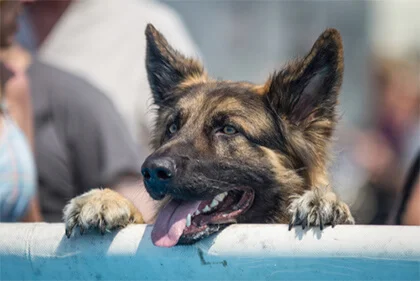The District Court of New South Wales Considers the Liability of a Dog Owner for the Injuries Sustained by a Five-Year-Old Boy Over Whilst Peering Over an Adjourning Fence in the Decision of Cuschieri Te Puia v Sheerin [2020] NSWDC 527.
IN BRIEF
On 14 September 2020, the District Court of New South Wales handed down the decision of Cuschieri Te Puia v Sheerin [2020] NSWDC 527. In this decision, Levy J found that a Defendant was strictly liable for the injuries that a five-year-old boy sustained whilst ‘peering’ over a fence at two large dogs.[1] Justice Levy rejected the Defendant’s reliance on the ‘Defence’ provided for by s 25(2) of the Companion Animals Act 1998 (NSW) and assessed the Plaintiff’s entitlement to damages at $315,500.00.[2]
THE MATERIAL FACTS
The Plaintiff was five years old when the subject dog attack occurred.[3]
The attack occurred on a private domestic property of a friend. The friend’s property adjourned the dog owner’s property.[4]
The two properties were divided by a dividing fence that was ‘in good working condition with no holes, gaps or damage’.[5]
The dogs involved in the attack were two large German Shepherds.[6]
The dog owner was not home at the time of the attack.[7]
The circumstances of the attack were that the Plaintiff was playing in the backyard of the property with another young child when he heard the dogs barking excitedly next door.[8] The Plaintiff, with the intention of ‘speaking to the dogs’, climbed up onto a tree stump placed against the fence and then climbed and stood upon a cross-beam of the dividing fence.[9]
After climbing onto the cross-beam of the dividing fence, the Plaintiff appeared within the line of sight of the dogs. It was at this point that the Plaintiff was attacked, mauled and wounded by the German Shepherds.[10]
One of the dogs leapt up and bit the Plaintiff on his right forearm and possibly on his right hand.[11] The other dog leapt up and bit him on the face.[12] The Plaintiff’s flesh and underlying tissue structures were exposed as a result of the attack.[13]
The Plaintiff alleged that he sustained the following injuries as a result of the attack:[14]
- A large bite mark adjacent to the area around the right eye with exposed fat tissue;
- A 10cm-12cm laceration around the right forearm wrapping around the arm with exposure of underlying fat tissue;
- A 3cm – 4cm wide laceration above the right forearm;
- Minor laceration to the left side of the nose;
- Subsequent scarring and permanent disfiguration; and
- Adjustment disorder with features of PTSDThe Plaintiff relied on expert medical evidence from a child psychiatrist and consultant plastic and reconstructive surgeon to establish his injuries and disabilities.[15] Similarly, the Defendant relied on expert evidence of a psychiatrist and plastic and reconstructive surgeon.[16]
RELEVANT LEGAL PRINCIPLES
The decision turned upon a determination of the Defendant’s liability under s 25 of the Companion Animals Act 1998 (NSW) (“the Act”),[17] which ordinarily imposes a strict liability on dog owners for the wounding or attacking of a person. His Honour was then required to assess the Plaintiff’s entitlement to damages arising from the attack.[18]
THE DECISION – WAS THE DOG OWNER LIABLE?
In determining the dog owner’s liability, His Honour was required to consider the Defendant’s Defence to the claim, which essentially alleged that:
- The Plaintiff was present on the Defendant’s property when the attack occurred; and
- The Plaintiff’s presence was an unlawful presence outside the liability of s 25 of the Act.[19]
There was no assertion that the Plaintiff’s attack was induced by an intentional provocation by the Plaintiff or his friend,[20] which could also serve as a Defence to the claim.
Did the attack occur whilst on the Defendant’s Property?
His Honour found that the Plaintiff was not on any property occupied by the Defendant at the time of the attack.[21] In coming to that conclusion, His Honour observed:[22]
- The Plaintiff’s head, torso, lower limbs and most (if not all) of his upper extremities were behind the dividing fence on the friend’s side of the fence;
- To the extent that the Plaintiff’s finger tips were on the top of the fence, the area was also part of the jointly occupied dividing fence;
- There was no evidence to suggest that any part of the Plaintiff’s body was protruding into the airspace over the Defendant’s premises;
- ‘Peeking’ over the fence should not be interpreted to mean that the Plaintiff’s head, or any part of his head, had actually protruded over the fence, or that any part of his body had invaded or had constituted an incursion into the airspace; and
- ‘Peeking’ should not be interpreted to mean that any part of the Plaintiff’s body was protruding into the Defendant’s airspace.
His Honour concluded that the mechanism of the dog attack described by the Plaintiff constituted an ‘attack’ and ‘wounding’ within meaning of s 25(1)(a) of the Act.[23] Justice Levy rejected the Defendant’s ‘speculative assertion’ that the initiating attack or wounding commenced and took place on the Defendant’s side of the fence.[24]Was the Plaintiff not Lawfully on the Defendant’s Property?
His Honour rejected the Defendant’s argument that the Plaintiff was a trespasser on the Defendant’s property at the time of the dog attack. In doing so, he rejected their reliance on s 25(2)(a) of the Act to avoid liability.[25] In making that finding, His Honour observed:[26]
- There was no part of the Plaintiff that was over the airspace before the mauling took place;
- The dogs assumed an attitude in which they separately launched themselves at the Plaintiff, with those actions constituting the initial phases of the attacks. The first physical contact and mailings that followed formed part of the continuum of attacks;
- No part of the Plaintiff’s body was relevantly on the Defendant’s property before those events occurred; and
- If there was an incursion, such as the tips of the Plaintiff’s fingers protruding into the airspace, this was in the nature of a casual, unintended or inadvertent incursion, which should not be characterised as an intentional trespass. It did not interfere with the Defendant’s use of the premises.
His Honour concluded that the statutory liability imposed by s 25(1) of the Act had not been shown to have been disapplied by reason of s 25(2) of the Act.[27] Thus, His Honour found the Defendant liable for the Plaintiff’s injuries and that the strict liability contemplated by the Act satisfied.
THE DECISION – ASSESSMENT OF DAMAGES
As the Defendant was liable for the dog attack, the Defendant was required to compensate the Plaintiff for his injury, loss and damage as governed by the Civil Liability Act 2002 (NSW).
The Plaintiff made a claim for the following damages arising from his injuries:[28]
- Non-economic loss;
- Future treatment expenses;
- Future impairment of his earning capacity; and
- Legal costs.
Non-economic loss
His Honour characterised the dog attack as a ‘horrific and scarifying experience’ that left the Plaintiff not only shocked, frightened and wounded, but also with disfiguring scars to the right forearm and face.[29]
His Honour accepted the Plaintiff’s expert evidence and observed that the Plaintiff’s fear of large dogs was not a minor matter in the case of a child.[30] He noted the Plaintiff’s significant scarring and the prospect of several future surgeries to lessen the severity of his disfiguring scars.[31] His Honour also noted the risk that the Plaintiff’s disfigurement and psychological sequela would create interpersonal difficulties for him in his social, personal and working future.[32]
His Honour opined that the Plaintiff’s past and likely future experiences called for ‘a substantial assessment of a percentage of impairment’. His Honour assessed the Plaintiff’s entitlement to non-economic loss damages at 35% of a most-extreme case, which equated to $230,500.00 at the time of the judgment.[33]
Future Earning Capacity
His Honour was of the view that it was reasonable to assume that the Plaintiff would be at a future disadvantage in competing for employment on account of his disfiguring scars to his face and right forearm.[34]
His Honour considered that the Plaintiff would need to avoid employment involving excessive unprotected sun exposure, as well as employment where the scarring would be exposed to the intrusive view of others where ‘foreseeable reactions might ensure’.[35]
His Honour assessed the Plaintiff’s entitlement to future economic loss on a buffer basis and awarded him $75,000.00 for his potential loss of future earning capacity.[36]
Future treatment
His Honour opined that the Plaintiff’s claim for future surgical treatment to the scarring, review by his general practitioner and sun protection creams was reasonable.[37] He awarded the Plaintiff’s damages for future treatment in the amount of $10,000.00. [38]
Costs
The Defendant was ordered to pay the Plaintiff’s legal costs on an ordinary basis, subject to the Plaintiff illustrating an entitlement to another type of costs order.[39]
LESSONS FROM THIS DECISION
This decision illustrates the Court’s sensible application of the Companion Animals Act 1998 (NSW) in circumstances where a young child was seriously wounded and disfigured.
In this case, notwithstanding the fact that the dogs were adequately secured on the Defendant’s property, the Plaintiff was able to succeed in a claim as the dogs attacked him and wounded him within meaning of the Act. The decision undoubtedly furthers the purpose of the Act and serves as an important reminder that companion animals must be effectively and responsibly managed and cared for, which is all the more important when young children are exposed to them.
Stacks Goudkamp has extensive experience acting for Plaintiffs who have been injured in dog attacks. For more information, and to arrange a free, no-obligation assessment of your claim, please contact Stacks Goudkamp on 1800 251 800, or alternatively, make an online enquiry.
Written by Megan Sault.
Megan Sault is a Solicitor in Alexander Morrison’s Practice Group at Stacks Goudkamp. Megan specialises in motor vehicle claims and public liability claims that occur both within Australia and overseas.
[1] Cuschieri Te Puia v Sheerin [2020] NSWDC 527 [78], [93] (Levy J).
[2] Ibid [141].
[3] Ibid [1].
[4] Ibid [6].
[5] Ibid [52].
[6] Ibid [1].
[7] Ibid [53].
[8] Ibid [10].
[9] Ibid.
[10] Ibid [23].
[11] Ibid [26].
[12] Ibid.
[13] Ibid.
[14] Ibid [58]-[62].
[15] Ibid [63-7].
[16] Ibid.
[17] Ibid [71].
[18] Ibid.
[19] Ibid.
[20] Ibid [76].
[21] Ibid [78].
[22] Ibid [79]-[85].
[23] Ibid [86].
[24] Ibid [88].
[25] Ibid [93].
[26] Ibid [94-98].
[27] Ibid [105].
[28] Ibid [116].
[29] Ibid [118].
[30] Ibid [119].
[31] Ibid [120].
[32] Ibid [121].
[33] Ibid [128].
[34] Ibid [132].
[35] Ibid.
[36] Ibid [133].
[37] Ibid [136].
[38] Ibid [137].
[39] Ibid [140]



